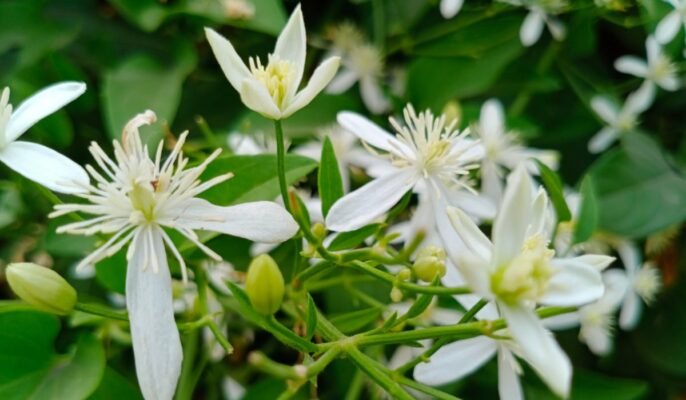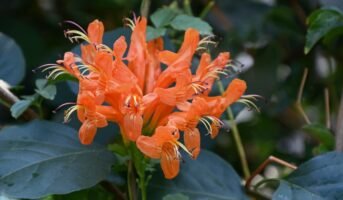Cestrum nocturnum, popularly known as Night-blooming jasmine, is a shrubby annual plant with graciously arching divisions surrounded with shiny, sharp, dark green foliage that is treasured for its intoxicating perfume. In the warmer months, a vast array of skinny, whipped cream-coloured flowers appear at night and close the following day. They emit a perfumy, alluring fragrance that uplifts the surrounding space.
See also: Arabian Jasmine: Significance, uses, care and maintenance tips
Cestrum nocturnum: Key Facts
| Common Name | Night-blooming jasmine |
| Scientific Name | Cestrum Nocturnum |
| Soil | Moist soil |
| Temperature | 16°C (60°F) to 30°C (86°F) |
| Water | Moderate |
| Sunlight | Plenty |
| Blooming time | February to March |
Cestrum Nocturnum: Physical description
Source: Pinterest
- Cestrum nocturnum is an annual woody flowering plant with slim branches that can reach a height of 4 m (13 ft). The plant has many components and is strongly foliated.
- The leaves are simple, limited petiolate, 6-20 cm (2.4-7.9 in) long and 2-4.5 cm (0.79-1.77 in) vast, seamless, and shiny, and have an entire edge.
- They are thinned in the front and slightly curved or blunt at the base. The leaf stalks range in length from 0.8 to 2 cm.
Cestrum Nocturnum: How to grow?
Source: Pinterest
Cestrum Nocturnum, commonly known as night-blooming jasmine or raat ki rani, is a fragrant flowering plant that is native to South America and the West Indies. Here are some general steps to help you grow Cestrum Nocturnum:
- Choose the right location: Cestrum nocturnum prefers a warm and sunny location with well-draining soil. It can grow in both full sun and partial shade.
- Planting: Plant the Cestrum Nocturnum in a hole that is twice the width of the root ball and at the same depth. Fill in the hole with soil, gently pat it down, and water it thoroughly.
- Watering: Cestrum Nocturnum needs regular watering, especially during the growing season. Water deeply once or twice a week, depending on the weather and the soil moisture.
- Fertilisation: Cestrum Nocturnum does not require much fertilisation. You can apply a balanced fertiliser once a month during the growing season.
- Propagation: Cestrum Nocturnum can be propagated by stem cuttings or by layering. Take stem cuttings in the spring or early summer, and plant them in moist soil. Layering can be done in the fall or winter by bending a stem to the ground and covering it with soil.
- Pests and diseases: Cestrum Nocturnum is relatively pest and disease-free. However, it can be susceptible to spider mites, scale insects, and mealybugs. Keep an eye out for any signs of infestation and treat with an appropriate insecticide if necessary.
Cestrum Nocturnum: Care tips
Here are some tips to help maintain Cestrum Nocturnum at home.
Cestrum Nocturnum: Sunlight requirements
This shrub thrives in at least six hours of bright sun daily but can also thrive in partial shade. An inordinate hue can decrease bloom quantity.
Cestrum Nocturnum: Soil requirements
Jasmine blooms at night in fertile, well-drained soil.
Cestrum Nocturnum: Water requirements
These plants like moisture. To ensure good, scented blooms, they require regular watering. They may need swamping several times per week while growing and then at least fortnightly after gaining a foothold during the planting season. Established plants will necessitate little irrigation even during the latent winter period.
Cestrum Nocturnum: Humidity and heat requirements
Night-blooming jasmines thrive in warm weather with high humidity. Although established plants can withstand temperatures as low as 25 degrees F, new growth will not survive in temperature changes below 35 degrees Fahrenheit. If temperatures fall below this level during the winter, sprout your tree in a carton that can be moved indoors.
Cestrum Nocturnum: Pruning requirements
Yearly pruning in the fall, after flowering has stopped, promotes thick, compact new growth and lessens the plant’s invasive characteristics since the berries’ seeds won’t be spread by birds that eat them.
Cestrum Nocturnum: Benefits
Following are some of the major benefits and uses of the plant.
Cestrum Nocturnum: Medicinal benefits
Night blooming jasmine has anti-inflammatory, anti-hyperlipidemic, cardioprotective, painkiller, antimicrobial, anti-convulsant, and insecticidal characteristics. A decoction of the leaves is applied as a moisturiser on inflamed skin in Central America and the Caribbean.
Cestrum Nocturnum: Wellness benefits
In the past, a fruit extract was used as a sleeping pill in epileptic seizures, apraxia, and histrionics, with the medicine being scaled back and eventually discontinued. The leaves are an independent provider for burn injuries and inflammations in Chinese folk medicine.
Cestrum Nocturnum: Rich in vitamins
It is high in vitamins A, B, C, D, E, and K, as well as magnesium, steel, potassium, calcium, salt, zinc, metals, trace elements, selenium, and fibre.
Cestrum Nocturnum: Saves from mosquito bites
They also work well against mosquito larvae. Mosquitoes eat blood and spread diseases like dengue fever, chikungunya, yellow flu, West Nile, and encephalopathy. In mosquito coils, night jasmine is frequently used.
Cestrum Nocturnum: Improves immunity
Night queen is also thought to improve immunity. It is commonly prescribed for people with allergies, asthma, bronchitis, or sinus problems.
Cestrum Nocturnum: Better sleep
Night jasmine is also thought to aid sleep. According to studies, people who breathe its scent feel extra at ease and relaxed.
FAQs
What is Cestrum nocturnum used for?
Aromatherapy uses night jasmine oil to reduce anxiety and stress. It aids in mood regulation by continuing to increase serotonin levels. Boil some leaves in liquid and consume them daily to relieve inflammation and pain in the body.
Is Cestrum Nocturnum toxic to pets?
Yes, Cestrum nocturnum is considered to be toxic, and all parts of the plant, including the flowers, leaves, and berries, contain toxic compounds.
| Got any questions or point of view on our article? We would love to hear from you.
Write to our Editor-in-Chief Jhumur Ghosh at jhumur.ghosh1@housing.com |
Housing News Desk is the news desk of leading online real estate portal, Housing.com. Housing News Desk focuses on a variety of topics such as real estate laws, taxes, current news, property trends, home loans, rentals, décor, green homes, home improvement, etc. The main objective of the news desk, is to cover the real estate sector from the perspective of providing information that is useful to the end-user.
Facebook: https://www.facebook.com/housing.com/
Twitter: https://twitter.com/Housing
Email: editor@housing.com

